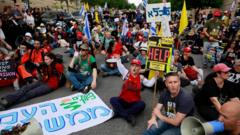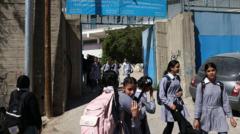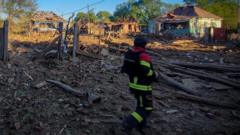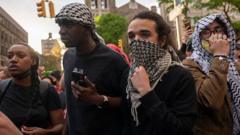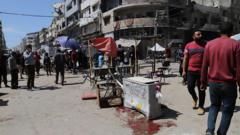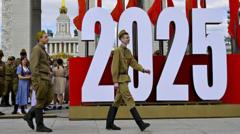In summary, while Hamas may publicly view the cease-fire as a victory, the prolonged military confrontation has severely compromised its operational capacity and leadership.
Cease-Fire Announced Amidst Weakened Hamas and Broader Regional Implications

Cease-Fire Announced Amidst Weakened Hamas and Broader Regional Implications
A recent cease-fire with Israel suggests a turning point for Hamas, significantly hindered after 15 months of conflict.
Gaza is witnessing a notable shift following the announcement of a cease-fire between Hamas and Israel, marking a significant moment in a conflict that has been ongoing since the devastating October 7, 2023, attacks. Despite Hamas's claims of victory, reports indicate that the militant group's military structure has been substantially weakened following Israel's relentless 15-month campaign, aimed at dismantling both Hamas's military capabilities and its regional proxy support network.
According to military analysts, Israel's sustained bombardment has severely diminished the effectiveness of Hamas's military wing, the Qassam Brigades, which once consisted of 21 battalions. Israeli military estimates from last September suggest that over 17,000 Hamas fighters have been killed during the conflict, including influential leaders. Senior commanders, such as Muhammad Deif and Yahya Sinwar, were reportedly killed in targeted operations, effectively disrupting the group’s command structure.
The damage is not confined to personnel losses; Hamas’s capacity to launch systematic and coordinated attacks has also been hampered. Israeli forces have effectively destroyed significant amounts of military hardware and undermined Hamas’s tunnel infrastructure, which was crucial for logistics and operational mobility. Additionally, a strategic land seizure along Gaza's southern border in May has restricted Hamas's ability to receive support from external sources like Egypt.
Ahron Bregman, a noted political scientist with expertise in Middle Eastern security, remarked on the effectiveness of Israel's extensive military operations, conveying that while infrastructure is diminished, the group has not capitulated. "Israel has turned Gaza into dust but Hamas is still standing and they have not raised the white flag," Bregman stated.
Moreover, the ramifications of the conflict extend beyond Gaza. The regional proxy network sustaining Hamas, particularly Hezbollah, has also faced significant setbacks. Israel intensified its military operations against Hezbollah from September onwards, culminating in targeted airstrikes and the elimination of their leader, Hassan Nasrallah. These strikes not only impacted Hezbollah's operational capabilities but also caused civilian casualties.
After a series of conflicts in Lebanon, a cease-fire was reached in November, obligating Hezbollah to cease its missile and drone assaults on Israel in response to support for Hamas. Furthermore, the recent overthrow of Syrian President Bashar al-Assad—seen as a critical ally in Iran's axis of resistance—presents additional complications for the arms supply chain to Hezbollah.
As cease-fire talks continue, the future landscape of both Hamas and its allied forces hinges on how regional dynamics evolve, alongside the group's strategic adjustments to sustain its presence in a dramatically altered geopolitical environment.
According to military analysts, Israel's sustained bombardment has severely diminished the effectiveness of Hamas's military wing, the Qassam Brigades, which once consisted of 21 battalions. Israeli military estimates from last September suggest that over 17,000 Hamas fighters have been killed during the conflict, including influential leaders. Senior commanders, such as Muhammad Deif and Yahya Sinwar, were reportedly killed in targeted operations, effectively disrupting the group’s command structure.
The damage is not confined to personnel losses; Hamas’s capacity to launch systematic and coordinated attacks has also been hampered. Israeli forces have effectively destroyed significant amounts of military hardware and undermined Hamas’s tunnel infrastructure, which was crucial for logistics and operational mobility. Additionally, a strategic land seizure along Gaza's southern border in May has restricted Hamas's ability to receive support from external sources like Egypt.
Ahron Bregman, a noted political scientist with expertise in Middle Eastern security, remarked on the effectiveness of Israel's extensive military operations, conveying that while infrastructure is diminished, the group has not capitulated. "Israel has turned Gaza into dust but Hamas is still standing and they have not raised the white flag," Bregman stated.
Moreover, the ramifications of the conflict extend beyond Gaza. The regional proxy network sustaining Hamas, particularly Hezbollah, has also faced significant setbacks. Israel intensified its military operations against Hezbollah from September onwards, culminating in targeted airstrikes and the elimination of their leader, Hassan Nasrallah. These strikes not only impacted Hezbollah's operational capabilities but also caused civilian casualties.
After a series of conflicts in Lebanon, a cease-fire was reached in November, obligating Hezbollah to cease its missile and drone assaults on Israel in response to support for Hamas. Furthermore, the recent overthrow of Syrian President Bashar al-Assad—seen as a critical ally in Iran's axis of resistance—presents additional complications for the arms supply chain to Hezbollah.
As cease-fire talks continue, the future landscape of both Hamas and its allied forces hinges on how regional dynamics evolve, alongside the group's strategic adjustments to sustain its presence in a dramatically altered geopolitical environment.


